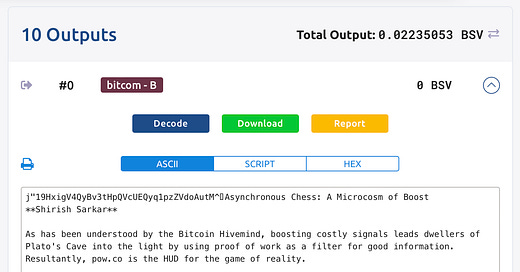This post was originally published on the BSV Bitcoin blockchain, viewable through this txid: 8f899bae9ef9d6446462d6deeb85395fce2ccf7b8e180cf506656989f0f3c3d6
or this link.
Asynchronous Chess: A Microcosm of Boost
**Shirish Sarkar**
As has been understood by the Bitcoin Hivemind, boosting costly signals leads dwellers of Plato's Cave into the light by using proof of work as a filter for good information. Resultantly, pow.co is the HUD for the game of reality.
We have come to understand that boosting is already a kind of game and that using elements of game design to make the experience as responsive as possible would be a worthwhile endeavor. I consider that something worth investing energy into figuring out. This however is not that idea.
Instead I propose a thought experiment for a hypothetical game of asynchronous chess as an educational tool for learning why boosting is valuable.
We imagine a standard game of chess where as usual white moves first. Some arbitrary difficulty threshold is established whereby players would boost all legal moves for white until the threshold is met. After this condition is fulfilled, the highest ranking move would execute, and the turn would switch to the black. Then the process repeats. Thus, we create a hivemind conscious that attempts to determine the best possible move for each side.
By giving players the ability to put a costly signal behind their move, we can imagine that the best possible move will be the one that passes the threshold. Chess is a reactive game, and playing it asynchronously allows for players of all skilltypes to spend as much time as possible considering all potential permutations of the next move. Then they would be forced to commit to this move using a costly signal. This also means players could be interested in playing both sides, as this performs like a general adversarial network, where two sides clash to produce the best output. So the outcome of the game is less important than the route taken to achieve it, since we can imagine the games themselves to move towards perfection.
Further thoughts - practically, a percentage of each move could be set aside to be split among the winning side using the winning moves. This would incentivize players to try their best, as well as play both sides of the game. Discussion about this post
No posts


